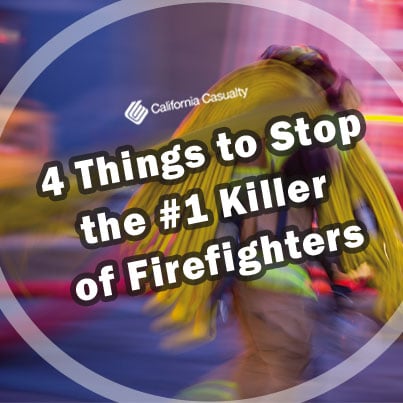In 2013, on duty deaths caused by sudden cardiac events accounted for 35% off on-duty deaths. That’s not including others who sustained damage to their hearts and cardiovascular systems but died off duty.
It should come as no surprise that the overall killer of American men is also the number one cause of death for firefighters—both on duty and off. What should come as a surprise is that in many ways, heart disease is preventable or at least manageable. The U.S. Fire Administration (USFA)’s 2013 annual report listed 37 firefighter deaths (out of 100) due to stress or exhaustion, a broader category including not just heart attacks but also strokes, or other similar medical events. Of those 37 on-duty deaths, 36 were heart attacks.
In fact, for the average American, heart disease is the number one killer. One in every four deaths in America is the result of heart disease. It’s no surprise then that an occupation that puts such strain on the body would see an increased risk as well (more than 1 in 3). It important to note the difference between career firefighter deaths caused by cardiac arrest and those of volunteers is staggering. In some years, more than 50 percent of all volunteer firefighter deaths were caused by cardiac events according to the NFPA.
A fatality of this sort doesn’t mean that the firefighter was in poor shape; the nature of the job contributes to the risk factors. But what can be said with certainty is that maintaining proper fitness can greatly affect the risk of heart disease, making it essential for such an at-risk group.
Heart health is about habits. And there are several things that you can do today to improve your own health, as well as the health of all the firefighters in your department.
- Get your checkup…and stay up-to-date
The first step is to keep a close eye on your health—making sure that you are regularly getting checkups with your doctor and that you are following medical advice and getting the care you need. The basic checkup exam can provide clues to your doctor regarding the health of your heart.
You heart can be damaged by high blood pressure and high cholesterol. It’s critical that you get both levels checked by a doctor on a regular basis. For your blood pressure, you should get checked at least every two years, according to the Mayo Clinic. If there are any risk factors present or your blood pressure rises, you’ll want to increase the frequency with which you get checked. You need to get your cholesterol checked less often, at least once every five years, unless there are additional risk factors.
- Make exercise a priority
Exercise is an absolutely crucial aspect of heart health. Exercise strengthens your heart, lowers your blood pressure, and can help decrease stress and boost your mood. Effective exercises include walking, running, biking or swimming. Anything that ups your heart rate and keeps it elevated for a period of 30 minutes will work.
Look at the American Heart Association’s Physical Activity Guidelines and think about how you can adopt them to stay healthier. In short, they recommend at least 150 minutes of moderate-intensity aerobic activity per week, or 30 minutes, five days a week.
Implementing change is always the hardest part. NVFC suggests that all departments adopt NFPA 1500: The Standard on Fire Department Occupational Health and Safety Program. They have created a step-by-step guide for implementation to help departments get started.
- Watch what you eat
Also look at how—and what—you’re eating. Switch to whole-grain where you can, and eat more omega-3 fatty acids, which can be found in foods like fish and walnuts. More generally, try to eat foods that are closest to their natural form. As a rule, these will be better for not just your heart, but you’re whole body.
Also consider how you can improve the diet of your fellow firefighters at the station. You can find options, such as oatmeal or black beans, which are both heart healthy and soft on the budget for on duty meals. But you can also leverage other members of your community. You may even be able to get a dietician, a nutrition student from a local community college, or even a local chef to donate some time at the station to help guide the on-duty diet.
- Take advantage of firefighter-specific heart health programs
Experts recommend that fire departments provide wellness and fitness programs that emphasize continued health of firefighters. These programs should include annual evaluations of physical performance.
You should familiarize yourself with the resources available to you. For example, the National Volunteer Fire Council’s Heart-Healthy Firefighter Program offers a number of resources for departments including information on how to implement a health and wellness program for your department, as well as offering workshops and training on building motivation for health in wellness in a department.
The International Association of Fire Chiefs (IAFC) also has a Wellness/Fitness Task Force, which offers three major programs of interest: the fitness initiative, seeking to build positive, individualized fitness programs, the candidate physical ability test in order to evaluate and assist in the selection of firefighters, and a firefighter peer fitness trainer certification.
There’s a lot of data that suggests you can better manage heart related illness and death. With such a large percentage of on-duty deaths due to cardiac arrest, it makes sense to mitigate those risks where possible. More importantly, that effort put into prevention can save lives and improve the quality of life for firefighters.
- California Casualty Earns Financial Stability Rating® of A, Exceptional, From Demotech, Inc. - April 28, 2025
- Music & Arts Grant Recipients – 2024 - December 13, 2024
- Understanding Auto and Home Insurance Rate Changes - December 3, 2024


